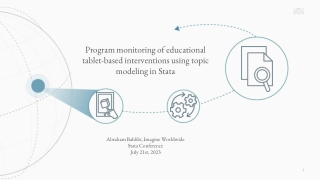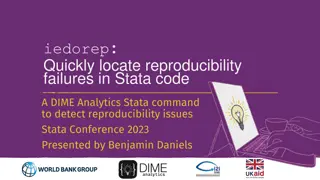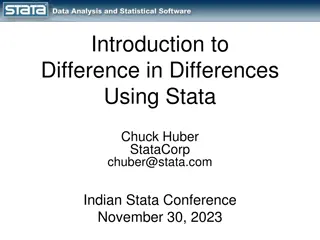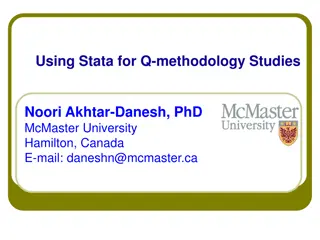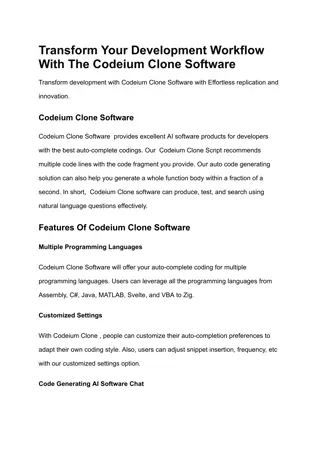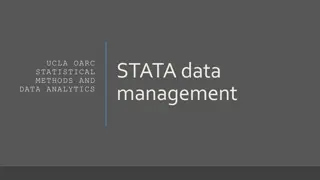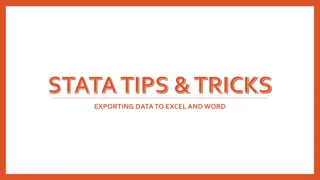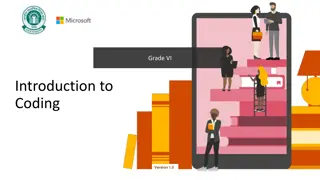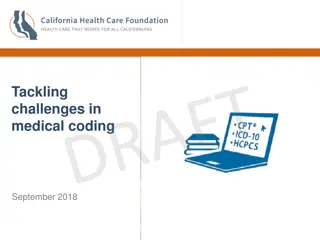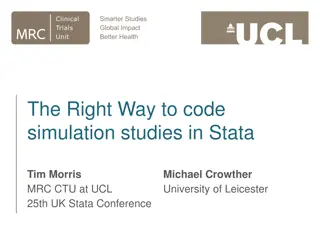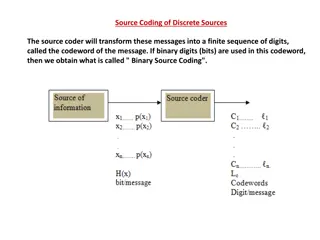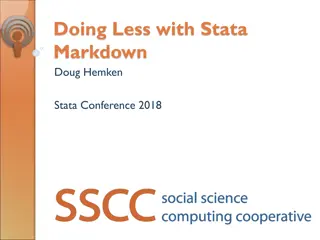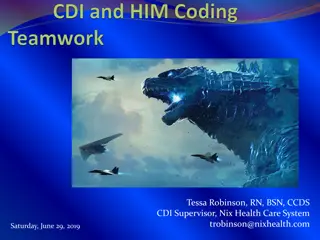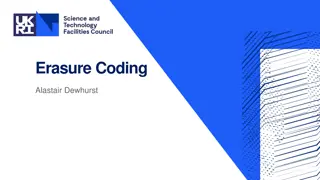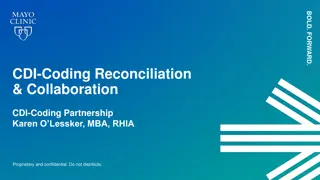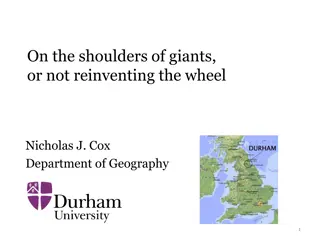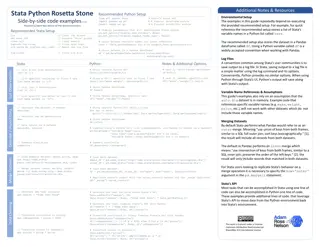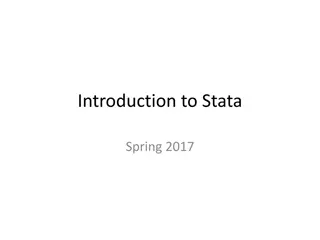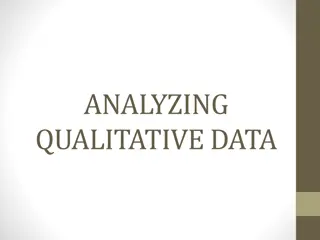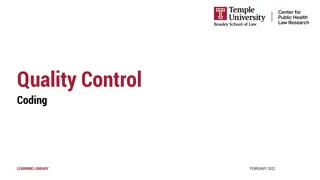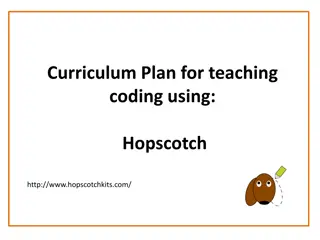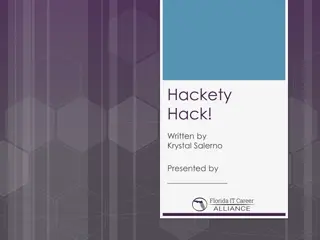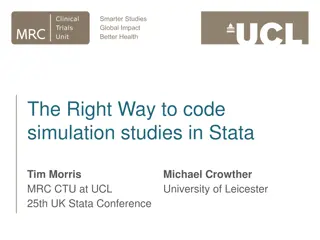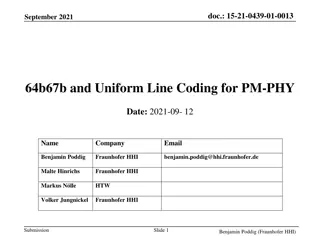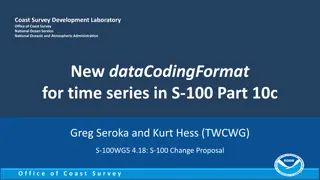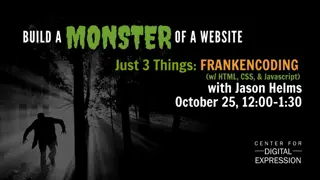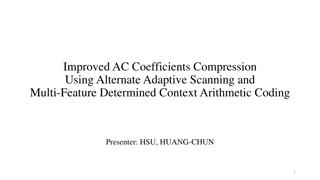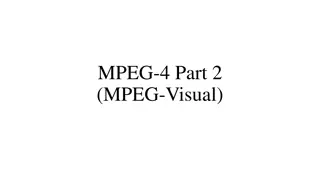Introduction to Stata
Powerful data analysis software, including data management, visualization, and statistical analysis. Seminar covers navigating Stata, data import, exploring and visualizing data, basic statistical analysis, and outputting to Word and Excel.
5 views • 126 slides
Program Monitoring with Topic Modeling in Stata
Explore how topic modeling using Stata aids in monitoring tablet-based educational interventions in Sub-Saharan Africa. Learn about the program's context, methodology, and results to enhance implementation quality. Popular
2 views • 15 slides
Stata's Capabilities for Efficiency and Productivity Assessment
Stata offers a range of tools for conducting frontier efficiency and productivity assessments, including nonparametric and parametric approaches, technical efficiency modeling, different orientations in DEA, productivity estimation techniques, and popular models like MPI and MLPI. The software empow
4 views • 50 slides
Introduction to Meta-analysis in Stata
This workshop, presented by Dr. Christine R. Wells from UCLA, provides an in-depth exploration of meta-analysis in Stata. Participants will learn about systematic reviews, data collection and organization, running meta-analyses, interpreting results, creating graphs, and identifying biases. The focu
2 views • 181 slides
Quickly locate reproducibility failures in Stata code
Explore DIME Analytics' Stata command for efficiently identifying reproducibility issues in Stata code, crucial in research to meet journal-led requirements and avoid potential setbacks. Learn more about the significance of reproducibility in data analysis projects and the tools provided by DIME Ana
0 views • 30 slides
Introduction to Difference in Differences Using Stata
Learn about Difference in Differences analysis using Stata with Chuck Huber at the Indian Stata Conference. The presentation covers the conceptual introduction, parallel trends assumption, and more using practical examples and panel data. Download slides and resources for further exploration.
3 views • 93 slides
Coding Club Essentials for Exciting Learning Adventures
Dive into the world of coding with Scratch and discover a community-driven space where creativity, collaboration, and problem-solving skills thrive. Explore the objectives, principles, goals, and structure of a coding club while envisioning your own journey towards mastering ICT skills and unleashin
5 views • 11 slides
Understanding Q-Methodology: A Stata Analysis Overview
Q-Methodology is a research approach focusing on subjective viewpoints. This article discusses the history, goals, and steps involved in a Q-methodology study using Stata programs. It covers the development of a concourse, creation of a Q-sample, Q-sorting activities, and analysis and interpretation
5 views • 46 slides
_Codeium Clone Software
Codeium Clone Software!\nEffortlessly create your own coding platform with our robust and scalable solution. Perfect for educational institutions, coding bootcamps, and tech companies. Enhance learning and streamline coding practice with ease.\nGet started today and revolutionise the way you teach a
0 views • 2 slides
Exploring Coding Platforms and Modules for Kids and Teens
Scratch, Python, Blockly, Code.org, Tynker, Micro:bit, LEGO Mindstorms, Swift Playgrounds, and more platforms offer engaging ways for children aged 8-16 to learn coding concepts. From visual programming to game development, robotics, and web development, these tools provide a fun and educational app
2 views • 10 slides
Data Management Workshop: Stata Commands for Statistical Analysis
This workshop conducted by UCLA's OARC covers essential Stata commands for preparing data sets for statistical analysis. It includes topics like inspecting and creating variables, handling missing data, merging datasets, and processing data efficiently. Participants will learn to use do-files, write
2 views • 79 slides
Exporting STATA Results to Excel Using PutExcel Feature
Learn how to utilize the PutExcel feature in STATA to effortlessly export your results to an Excel file. With PutExcel, you can export matrices, stored results, images, estimation tables, and even add formulas for calculations. This tool streamlines the process of transferring statistical data to Ex
3 views • 32 slides
Introduction to Coding: A Journey into the World of Programming
Dive into the world of coding with Grade VI as they explore ethical practices, real-world applications, and the impact of coding on daily life. Discover the magic behind traffic lights, the ubiquity of coding in modern society, and the essence of programming languages like Python, Java, and JavaScri
1 views • 46 slides
Challenges in Medical Coding: A Critical Look at Errors and Solutions
Medical coding plays a crucial role in translating patient encounters into billable data, but incorrect coding poses significant challenges. Billing error rates are high, impacting providers, patients, and payers. Each step in the coding process has its issues, such as incomplete documentation and l
2 views • 5 slides
Panel Stochastic Frontier Models with Endogeneity in Stata
Introducing xtsfkk, a new Stata command for fitting panel stochastic frontier models with endogeneity, offering better control for endogenous variables in the frontier and/or the inefficiency term in longitudinal settings compared to standard estimators. Learn about the significance of stochastic fr
0 views • 13 slides
Coding Simulation Studies in Stata: A Practical Approach
Understanding simulation studies and their importance in evaluating statistical methods, this presentation delves into the precise coding techniques required in Stata to generate simulated datasets, produce estimates, and analyze performance metrics. With a focus on consistent terminology, data-gene
5 views • 18 slides
Understanding Source Coding for Discrete Sources
Source coding involves transforming messages into codewords, with considerations for minimizing code length and ensuring unique decodability. Binary source coding and efficiency are key concepts explored in this process. Check out the details and examples provided to deepen your understanding of sou
0 views • 14 slides
Doing Less with Stata Markdown
Explore how Stata Markdown simplifies the process of combining analysis and write-up, making it easy to read and write. Learn about the integration of Markdown with dynamic Stata code to automate document assembly, providing a seamless workflow for researchers and analysts.
0 views • 18 slides
CDI-Coding Reconciliation Process Overview
CDI-Coding reconciliation is crucial for ensuring complete and accurate documentation and coding in healthcare settings. This process involves reviewing medical records, comparing CDI findings with coding summaries, and making necessary adjustments to align final DRGs. Collaboration between CDI, HIM
0 views • 16 slides
Understanding Erasure Coding in Storage Systems
Erasure Coding is a data storage technique that enhances fault tolerance by breaking files into chunks and generating additional pieces for reconstruction. This technology, exemplified by systems like Ceph, offers more robust data protection than traditional methods like RAID or replication. Erasure
0 views • 10 slides
Inpatient CDI/Coding Reconciliation Process Overview
This document outlines the integrated process of CDI/coding reconciliation in inpatient settings, emphasizing collaboration between CDI specialists and coders to ensure accurate documentation, ICD-10 coding, and DRG reporting. Key focus areas include physician queries, documentation improvement oppo
3 views • 9 slides
On the Shoulders of Giants: Harnessing Powerful Commands in Stata for Efficient Coding
Stata users can enhance their coding efficiency by utilizing powerful commands that are often overlooked. This presentation showcases examples of commands that can streamline coding work, ranging from interactive use to supporting long programs. By leveraging these commands, users can avoid reinvent
0 views • 51 slides
Enhancing Occupation Coding Efficiency During Interviews in Mixed-Mode Surveys
Explore the benefits of coding occupation data during interviews in web-first mixed-mode surveys. Previous research suggests reduced errors, improved data quality, and cost/time savings. The practice involves open-ended questions, manual or computer-aided coding, and potential interviewer advantages
1 views • 22 slides
Stata-Python Rosetta Stone: Side-by-side Code Examples v1.0
A comprehensive guide providing side-by-side code examples in Stata, Python, and R, facilitating easy translation between the languages. It covers setting up Python for Stata, handling dataframes, storing datasets, working with log files, merging datasets, describing and summarizing data, and more.
1 views • 21 slides
Introduction to Stata Programming Basics
Explore the fundamentals of Stata programming, including navigating the Stata system, manipulating data, creating variables, and working with the Stata screen. Learn essential syntax rules, setting up the Do file, and accessing and managing data in Stata.
0 views • 30 slides
Analyzing Qualitative Data: Steps and Coding Methods
Understanding qualitative data analysis involves several key steps, such as preparing the data through transcription, developing codes and categories using content analysis, revising categories based on the data, and reporting the analysis results. Content analysis helps in identifying words, themes
0 views • 32 slides
Quality Control Coding Process in Research
Learn how to ensure quality in coding processes through redundant coding, defining coding types, and conducting final quality control checks. Supervisors review researchers' work to identify issues and divergence, maintaining accuracy in research coding practices.
0 views • 20 slides
Further Considerations on Advanced Channel Coding for 15.4ab
This document submitted to the IEEE P802.15 Working Group discusses the importance of advanced channel coding for IEEE 802.15.4ab standard to achieve higher throughput and reliability. It outlines technical guidance on proposed solutions, safeguards, interference mitigation techniques, and backward
0 views • 14 slides
Engaging Coding Curriculum Using Hopscotch for Young Learners
Explore an innovative curriculum plan using Hopscotch kits to teach coding to children in a fun and interactive way. The plan focuses on refreshing coding knowledge, developing creative thinking, and integrating coding projects with other subjects for a cross-curricular approach. Dive into drawing,
0 views • 12 slides
Understanding Binary Codes and Character Coding Techniques
Binary codes, such as ASCII and EBCDIC, are crucial in representing data in computers and digital systems. They play a key role in error detection and data encoding. This article discusses the basics of binary coding, various types of binary codes, character coding techniques like ASCII and EBCDIC,
0 views • 22 slides
Practical Implementations of Arithmetic Coding
Explore the practical implementations, advantages, and disadvantages of arithmetic coding in this informative guide. Learn about the basic algorithm, dynamic interval expansion, integer arithmetic coding, and methods to improve the speed of arithmetic coding. Dive deep into encoding algorithms, exam
0 views • 78 slides
Learn Coding with Hackety Hack in Ruby: A Fun Introduction to Programming
Discover Hackety Hack, a beginner-friendly Ruby-based program that makes coding fun and easy. Learn the basics of coding, variables, asking questions, drawing with Turtle, and using loops to simplify repetitive tasks. Start your coding journey today with Hackety Hack!
0 views • 23 slides
The Right Way to Code Simulation Studies in Stata
Simulation studies in Stata involve using (pseudo) random numbers to generate data from a distribution for studying statistical methods. This process helps to evaluate different scenarios and understand the properties of statistical techniques. Key components like ADEMP (Aims, Data-generating mechan
1 views • 18 slides
Optimizing Line Coding for PM-PHY: A Detailed Analysis
Enabling line coding and channel equalization methods for PM-PHY, the IEEE 802.15.13 standard introduces overhead while enhancing channel adaptation. This contribution proposes 64b67b and Uniform Line Coding as alternative transmission modes, aiming to reduce line coding overhead while maintaining a
0 views • 26 slides
Proposal for New Data Coding Format in Time Series - S-100 Change
A new data coding format is proposed for fixed station time series organization. The proposal includes extensions and clarifications to Part 10c in S-100 for supporting time series data. The comparison between data coding formats 1 and 8 highlights differences in handling real-time data, time interv
0 views • 10 slides
Coding Tips and Practices for Success
Explore essential coding practices such as working with linked files, debugging techniques, rubber duck debugging, frank encoding, and more to enhance your coding skills and efficiency. Discover the core elements of HTML, CSS, and JavaScript and learn how to optimize your coding process for better r
0 views • 14 slides
Enhancing Death Registration Process in Botswana
Strategies to address bottlenecks in institutional deaths in Botswana include decentralizing coding, simplifying ICD processes, enhancing staff training, strengthening partnerships, and increasing coding staffing. The death registration process involves reporting in health facilities, coding and dat
0 views • 7 slides
Enhanced AC Coefficients Compression Techniques
Explore improved methods for compressing AC coefficients in JPEG coding, utilizing alternate adaptive scanning and multi-feature determined context arithmetic coding. The approach involves scanning order determination, entropy coding, and arithmetic coding techniques to enhance compression efficienc
0 views • 10 slides
Understanding MPEG-4 Video Coding
MPEG-4 video coding involves various tools and techniques such as MPEG-Visual, Simple Profile, Quantization Methods, Motion Compensation, Coding Efficiency Tools, Transmission Efficiency Tools, and Advanced Simple Profile. These tools define specific features, coding functions, and constraints for o
0 views • 27 slides
Theo Holroyd's Journey: From Code Jumper to Python
Theo Holroyd, a 15-year-old from Cambridge, England, shares his remarkable journey into the world of technology, coding, and Python programming. Despite facing challenges accessing traditional coding classes, Theo's passion for coding led him to explore Python with the help of accessible tools. Thro
0 views • 17 slides

